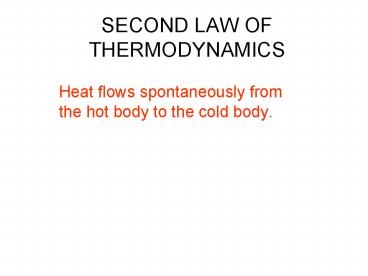SECOND LAW OF THERMODYNAMICS PowerPoint PPT Presentation
1 / 13
Title: SECOND LAW OF THERMODYNAMICS
1
SECOND LAW OF THERMODYNAMICS
- Heat flows spontaneously from the hot body to the
cold body.
2
SECOND LAW OF THERMODYNAMICS
- Heat flows spontaneously from the hot body to the
cold body. - Not all thermal energy in a thermal system is
available to do work.
3
SECOND LAW OF THERMODYNAMICS
- Heat flows spontaneously from the hot body to the
cold body. - Not all thermal energy in a thermal system is
available to do work. - These facts are important in the design of
engines and refrigerators
4
SECOND LAW OF THERMODYNAMICS
- Engine model takes in QH and exhausts QC .
High Temperature Reservoir
QH
Engine
? W
Qc
Low Temperature Reservoir
5
SECOND LAW OF THERMODYNAMICS
- Spontaneous process of the directivity of heat
traveling from hot ? cold body
6
SECOND LAW OF THERMODYNAMICS
- Spontaneous process of the directivity of heat
traveling from hot ? cold body is equivalently
explained in the ideas of probability.
7
SECOND LAW OF THERMODYNAMICS
- Spontaneous process of the directivity of heat
traveling from hot ? cold body is equivalently
explained in the ideas of probability. - In equilibrium, molecules will move to the
condition where there are more possibilities.
8
SECOND LAW OF THERMODYNAMICS
- Kelvin It is impossible to construct a cyclic
engine that converts thermal energy from a body
into an equivalent amount of mechanical work
without a further change in its surroundings.
9
SECOND LAW OF THERMODYNAMICS
- Kelvin It is impossible to construct a cyclic
engine that converts thermal energy from a body
into an equivalent amount of mechanical work
without a further change in its surroundings. - Clausius It is impossible to construct a cyclic
engine whose only effect is to transfer thermal
energy from a colder body to a hotter body.
10
SECOND LAW OF THERMODYNAMICS
- There are thermodynamic cycles for each
thermodynamic engine (cyclic process).
11
SECOND LAW OF THERMODYNAMICS
- There are thermodynamic cycles for each
thermodynamic engine (cyclic process). The most
common engine cycles are the - Carnot, Otto, Diesel, Brayton and Rankine
12
SECOND LAW OF THERMODYNAMICS
- There are thermodynamic cycles for each
thermodynamic engine (cyclic process). The most
common engine cycles are the - Carnot, Otto, Diesel, Brayton and Rankine
- To see a treatment of the different types of
cycles see the following link.
13
SECOND LAW OF THERMODYNAMICS
- There are thermodynamic cycles for each
thermodynamic engine (cyclic process). The most
common engine cycles are the - Carnot, Otto, Diesel, Brayton and Rankine
- To see a treatment of the different types of
cycles see the following link. - http//en.wikipedia.org/wiki/Internal_combustion_e
ngine

